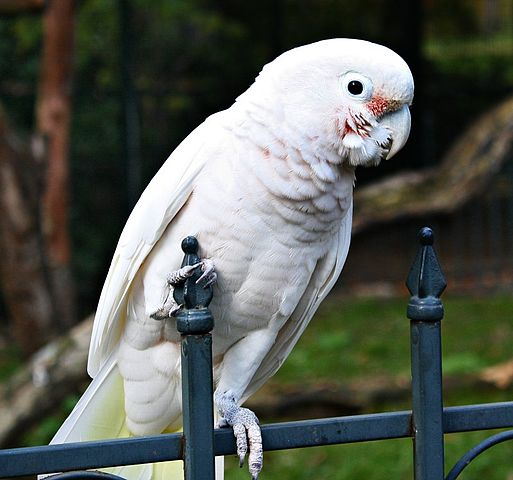The goffins cockatoo is a very high-energy bird that won’t sit still for a moment. Since it seems to be singularly focused on anything it is not supposed to have, it needs constant entertainment and vigilant supervision. Some people might consider THIS to be a problem, but it is simply their nature and if it is an undesirable quality to your way of thinking, best you look elsewhere for a bird species.
If you are the type of owner who delights in a bird with a strong personality, you need to look no further. The goffins have the same pleasing attributes as the larger white cockatoos without as much drama and fuss. The beautiful goffins cockatoo loves a good cuddle but doesn’t become desperately reliant on physical attention like the larger cockatoos are known to. They aren’t the diva that will treat you like a criminal for a week because their food arrived at the wrong temperature. A goffins doesn’t have time for such nonsense.

Sounds like the perfect bird, you say? There’s no such thing, we say back. Parrots are highly intelligent creatures, and with intelligence comes complexity and unpredictability. Every parrot has the potential to present their owner with at least some challenge that will force him to seek the advice of others more experienced. Your goffins are no exception.
It’s fair to call the goffins cockatoo a high-strung bird. It is obvious in their crest, which raises whenever there is any excitement – it gets a workout each day. High-strung birds, however, sometimes develop fears that are unforeseen and seem irrational. The goffins are no exception here either.
Overreaction
When a goffins cockatoo sees something that causes alarm, one of two personalities will emerge: either they will run away or they will take an aggressive stand. This is pretty typical behavior for any bird species (fight or flight), but we are talking about a cockatoo – they never do anything in a small way.
My newly rehomed goffins cockatoo could find fault with nearly anything, and being a cockatoo, would always overreact to it. I came home one day wearing a new pair of flip-flops. The minute I walked in the door, she grew about 4 inches and took to the air screaming like a little girl. She never took her eyes off my feet. I would have expected that level of drama if I had walked into the house with a hawk on my shoulder. I could practically hear her blood pressure rising.
Interestingly, she watched me throw the shoes in the trash that night (they obviously had to go), and she transferred her misgivings over to the trash can. Did I say that goffins cockatoos were not divas?
On the other side of the behavioral coin was my friend’s goffins – his bird had the same proclivity for finding inanimate objects threatening. His wife came home one day wearing a new gold barrette in her hair. BIG mistake.
The bird attached himself to the back of her head and couldn’t be removed until the barrette was on the floor, unfortunately, it was still attached to some of her hair. He did a victory dance on top of the fridge.
These are not “bad” behaviors, you can’t call a behavior bad when a bird is acting in accordance to its nature– but they are not good behaviors either. These are the behaviors of birds that have not been given exposure to new things or new experiences. Birds are suspicious by nature, they have to be. It is a good survival strategy for a prey animal. But when you put that mentality into the brain of a highly-strung cockatoo, the result is an overreaction.
How to raise a well-balanced goffin cockatoo
Some will tell you that the words “well-balanced” and “cockatoo” do not belong in the same sentence. I disagree. While the goffins cockatoo might present some unusual challenges they, like every other parrot out there, can be taught to accept the new things that life has in store (or on feet, or in hair).
You need to give your cockatoo one new experience a day. This could be letting him check out your key ring, going into a room with you that he doesn’t get to visit, or playing with an ice cube on a plate. It doesn’t have to be a big deal – just new and different. This will teach him over time that new things are not “bad” things. Repeated positive experiences will hammer that message home.
One of the best ways to give your bird a new experience is through training. Not only is it a great bond-building experience, but as you move from stage to stage in training your bird gets a new experience to learn and master.
